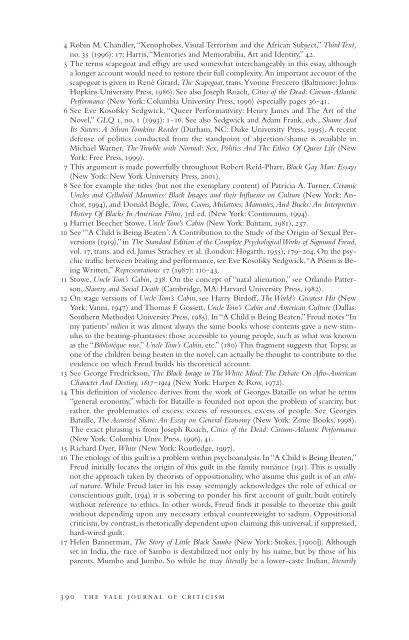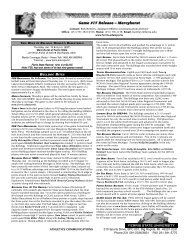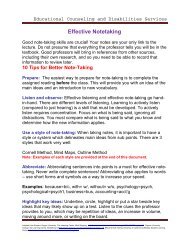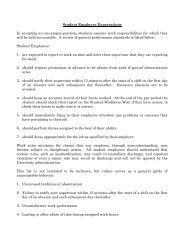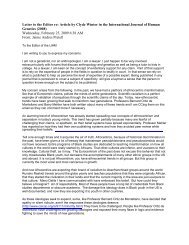Tavia Nyong'o Racial Kitsch and Black Performance - Ferris State ...
Tavia Nyong'o Racial Kitsch and Black Performance - Ferris State ...
Tavia Nyong'o Racial Kitsch and Black Performance - Ferris State ...
You also want an ePaper? Increase the reach of your titles
YUMPU automatically turns print PDFs into web optimized ePapers that Google loves.
4 Robin M. Ch<strong>and</strong>ler,“Xenophobes, Visual Terrorism <strong>and</strong> the African Subject,” Third Text,<br />
no. 35 (1996): 17;Harris,“Memories <strong>and</strong> Memorabilia, Art <strong>and</strong> Identity,” 42.<br />
5 The terms scapegoat <strong>and</strong> effigy are used somewhat interchangeably in this essay, although<br />
a longer account would need to restore their full complexity. An important account of the<br />
scapegoat is given in René Girard, The Scapegoat, trans.Yvonne Freccero (Baltimore: Johns<br />
Hopkins University Press, 1986). See also Joseph Roach, Cities of the Dead: Circum-Atlantic<br />
<strong>Performance</strong> (New York: Columbia University Press, 1996) especially pages 36‒41.<br />
6 See Eve Kosofsky Sedgwick, “Queer Performativity: Henry James <strong>and</strong> The Art of the<br />
Novel,” GLQ 1,no.1 (1993): 1‒16. See also Sedgwick <strong>and</strong> Adam Frank, eds., Shame And<br />
Its Sisters: A Silvan Tomkins Reader (Durham, NC: Duke University Press, 1995). A recent<br />
defense of politics conducted from the st<strong>and</strong>point of abjection/shame is available in<br />
Michael Warner, The Trouble with Normal: Sex, Politics And The Ethics Of Queer Life (New<br />
York: Free Press, 1999).<br />
7 This argument is made powerfully throughout Robert Reid-Pharr, <strong>Black</strong> Gay Man: Essays<br />
(New York: New York University Press, 2001).<br />
8 See for example the titles (but not the exemplary content) of Patricia A. Turner, Ceramic<br />
Uncles <strong>and</strong> Celluloid Mammies: <strong>Black</strong> Images <strong>and</strong> their Influence on Culture (New York: Anchor,<br />
1994), <strong>and</strong> Donald Bogle, Toms, Coons, Mulattoes, Mammies,And Bucks:An Interpretive<br />
History Of <strong>Black</strong>s In American Films, 3rd ed. (New York: Continuum, 1994).<br />
9 Harriet Beecher Stowe, Uncle Tom's Cabin (New York: Bantam, 1981), 237.<br />
10 See “‘A Child is Being Beaten’: A Contribution to the Study of the Origin of Sexual Perversions<br />
(1919),” in The St<strong>and</strong>ard Edition of the Complete Psychological Works of Sigmund Freud,<br />
vol. 17, trans. <strong>and</strong> ed. James Strachey et al. (London: Hogarth, 1955), 179‒204.On the psychic<br />
traffic between beating <strong>and</strong> performance, see Eve Kosofsky Sedgwick,“A Poem is Being<br />
Written,” Representations 17 (1987): 110‒43.<br />
11 Stowe, Uncle Tom’s Cabin, 238.On the concept of “natal alienation,” see Orl<strong>and</strong>o Patterson,<br />
Slavery <strong>and</strong> Social Death (Cambridge, MA: Harvard University Press, 1982).<br />
12 On stage versions of Uncle Tom’s Cabin, see Harry Birdoff, The World’s Greatest Hit (New<br />
York: Vanni, 1947) <strong>and</strong> Thomas F. Gossett, Uncle Tom’s Cabin <strong>and</strong> American Culture (Dallas:<br />
Southern Methodist University Press, 1985). In “A Child is Being Beaten,” Freud notes “In<br />
my patients’ milieu it was almost always the same books whose contents gave a new stimulus<br />
to the beating-phantasies: those accessible to young people, such as what was known<br />
as the “Bibliotèque rose,” Uncle Tom’s Cabin, etc.” (180) This fragment suggests that Topsy, as<br />
one of the children being beaten in the novel, can actually be thought to contribute to the<br />
evidence on which Freud builds his theoretical account.<br />
13 See George Fredrickson, The <strong>Black</strong> Image in The White Mind:The Debate On Afro-American<br />
Character And Destiny, 1817–1914 (New York: Harper & Row, 1972).<br />
14 This definition of violence derives from the work of Georges Bataille on what he terms<br />
“general economy,” which for Bataille is founded not upon the problem of scarcity, but<br />
rather, the problematics of excess: excess of resources, excess of people. See Georges<br />
Bataille, The Accursed Share:An Essay on General Economy (New York: Zone Books, 1998).<br />
The exact phrasing is from Joseph Roach, Cities of the Dead: Circum-Atlantic <strong>Performance</strong><br />
(New York: Columbia Univ. Press, 1996), 41.<br />
15 Richard Dyer, White (New York: Routledge, 1997).<br />
16 The etiology of this guilt is a problem within psychoanalysis. In “A Child is Being Beaten,”<br />
Freud initially locates the origin of this guilt in the family romance (191). This is usually<br />
not the approach taken by theorists of oppositionality, who assume this guilt is of an ethical<br />
nature. While Freud later in his essay seemingly acknowledges the role of ethical or<br />
conscientious guilt, (194) it is sobering to ponder his first account of guilt, built entirely<br />
without reference to ethics. In other words, Freud finds it possible to theorize this guilt<br />
without depending upon any necessary ethical counterweight to sadism. Oppositional<br />
criticism, by contrast, is rhetorically dependent upon claiming this universal, if suppressed,<br />
hard-wired guilt.<br />
17 Helen Bannerman, The Story of Little <strong>Black</strong> Sambo (New York: Stokes, [1900]). Although<br />
set in India, the race of Sambo is destabilized not only by his name, but by those of his<br />
parents, Mumbo <strong>and</strong> Jumbo. So while he may literally be a lower-caste Indian, literarily<br />
390<br />
t he yale journal of criticism


